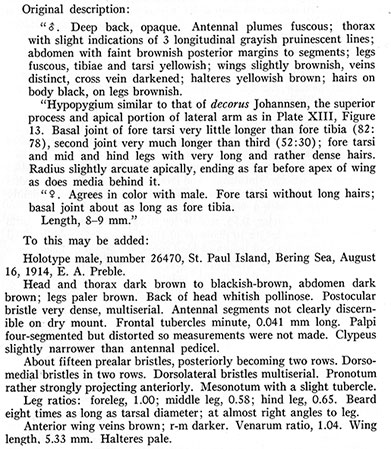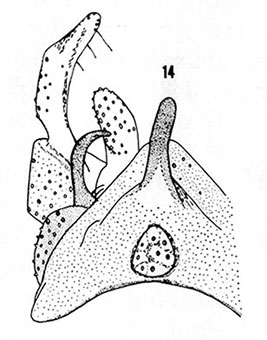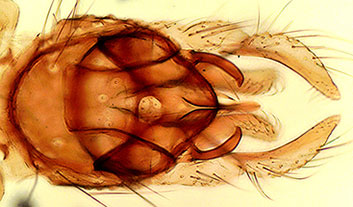Species 5g. C. sanctipauli, Sublette 1966.Adult  Description of C. sanctipauli, including original description as C. conformis, from Sublette (1966). Note: 'deep back' should read 'deep black' Male: Wing length 5.33 mm; VR 1.04 (0.96). Frontal tubercles 41 µm. Clypeus slightly narrower than diameter of antennal pedical. Mesonotum with slight tubercle. Acrostichal setae in two rows; dorsomedial multiserial; prealar about 15. Leg ratios: Ant 1.0-1.05; Mid 0.58; Hind 0.65. BR 8.0. Tergite IX with about 8 setae in a subdivided pale patch.  Hypopygium of holotype male (from Sublette 1966) A possible additional male specimen from Alaska was collected by P.L. Hudson and A. Namayanden.  Hypopygium of possible male (from Hudson & Namayanden) Female: Length 8-9 mm. LR about 1; no beard. Pupa, Fourth instar larva and Cytology: Unknown Alaska - St Paul Island, Bering Sea (57.18°N, -170.27°W) (Type locality); Margaret Lake, near Beaver Pond, Revillagigedo Island (55.33°N, -131.33°W). Townes (1945) considered C. conformis to be a synonym of C. pilicornis but, in renamimg it, Sublette noted that it differed in significant ways: the anal point is broader, the Superior volsella more conspicuously hooked, the gonostyles more distinctly tapered apically and the ninth tergite with a conspicuous patch of setae, so considered it a new species closely related to C. pilicornis. It would also be closely related to Species 5e, but there is no mention of a pale scutellum. |
Updated: 31 March 2024
Access: Unrestricted
Copyright © 2018-2024, Jon Martin.